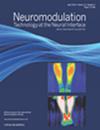经皮电刺激对胸腰椎骨折术后恢复的促进作用与交感神经活动和白细胞介素-6抑制相关。
IF 3.2
3区 医学
Q2 CLINICAL NEUROLOGY
引用次数: 0
摘要
目的:胃肠道(GI)紊乱是胸腰椎骨折(TVF)患者的常见并发症。经皮电刺激(TEA)已被报道能有效地加速腹部手术后胃肠道功能的恢复。本研究旨在探讨TEA对术后恢复的影响及其相关机制。材料和方法:81例择期行后路椎弓根螺钉固定手术的TVF患者随机分为TEA组和假TEA组。术前24小时至术后1天(POD),每日2次,每次1小时。然后在不同的时间点以日记的形式评估效果。结果:与sham-TEA相比,TEA减轻了术后与低GI运动相关的损伤,包括排便时间减少27.2% (p = 0.002 vs sham-TEA),首次放屁时间减少17.2% (p = 0.027), Bristol粪便评分增加(p = 0.014),自发排便次数增加(p = 0.009)。TEA还缓解了其他胃肠道症状,包括POD1和POD4的腹胀(分别p < 0.001和p = 0.001),排便时紧张(p < 0.001),排便时肛门直肠阻塞感(p = 0.02)。此外,TEA降低了POD1 (p = 0.026)、POD2 (p < 0.001)和POD3 (p < 0.001)的视觉模拟量表伤口疼痛评分,增加了迷走神经活动,降低了交感神经活动(p < 0.001),此外还抑制了POD1 (p = 0.047)和POD4 (p = 0.036)的血清去甲肾上腺素水平。茶导致血清白细胞介素-6从POD1到POD4的下降幅度较大(p = 0.011,与假茶相比)。TEA的使用是首次排便时间缩短的独立预测因子。结论:与假TEA相比,ST36处无创TEA可通过增强迷走神经和抑制交感神经活动,有效促进TVF患者术后恢复。临床试验注册:该研究在www.chictr.org.cn(中国临床试验注册中心ChiCTR2300078195)上回顾性注册。本文章由计算机程序翻译,如有差异,请以英文原文为准。
Accelerative Effects of Transcutaneous Electrical Acustimulation on Postoperative Recovery After Thoracolumbar Vertebral Fracture Associated With Suppressed Sympathetic Activity and Interleukin-6
Objectives
Gastrointestinal (GI) disturbance is a frequent complication in patients with thoracolumbar vertebral fracture (TVF). Transcutaneous electrical acustimulation (TEA) has been reported to effectively accelerate postoperative GI function recovery after abdominal surgery. This study aimed to investigate the effects of TEA on postoperative recovery and the associated mechanisms.
Materials and Methods
A total of 81 patients with TVF who underwent elective posterior pedicle screw fixation surgery were randomized to receive TEA or sham-TEA. TEA at ST36 or sham-TEA at nonacupoints was performed for one hour twice daily, from 24 hours before surgery to postoperative day (POD) 3. The effects were then assessed in the form of a diary at different time points.
Results
Compared with sham-TEA, TEA attenuated postoperative impairments associated with lower GI motility, including a reduction in time to defecation by 27.2% (p = 0.002 vs sham-TEA), time to first flatus by 17.2% (p = 0.027), an increase in the Bristol stool score (p = 0.014), and the number of spontaneous bowel movement (p = 0.009). TEA also relieved other GI symptoms including abdominal bloating on POD1 and POD4 (p < 0.001 and p = 0.001, respectively), straining during defecation (p < 0.001), and sensation of anorectal blockage during defecation (p = 0.02). Moreover, TEA reduced the visual analog scale wound pain score on POD1 (p = 0.026), POD2 (p < 0.001), and POD3 (p < 0.001), increased vagal activity, and decreased sympathetic activity (p < 0.001), in addition to suppressing the serum level of norepinephrine on both POD1 (p = 0.047) and POD4 (p = 0.036). TEA caused a higher decrease from POD1 to POD4 in serum interleukin-6 (p = 0.011, vs sham-TEA). The use of TEA was an independent predictor of shortened time to first defecation.
Conclusion
Noninvasive TEA at ST36, in comparison with sham-TEA, is effective in promoting postoperative recovery in patients with TVF by enhancing vagal and suppressing sympathetic activities.
Clinical Trial Registration
The study was retrospectively registered on www.chictr.org.cn (Chinese Clinical Trial Registry ChiCTR2300078195).
求助全文
通过发布文献求助,成功后即可免费获取论文全文。
去求助
来源期刊

Neuromodulation
医学-临床神经学
CiteScore
6.40
自引率
3.60%
发文量
978
审稿时长
54 days
期刊介绍:
Neuromodulation: Technology at the Neural Interface is the preeminent journal in the area of neuromodulation, providing our readership with the state of the art clinical, translational, and basic science research in the field. For clinicians, engineers, scientists and members of the biotechnology industry alike, Neuromodulation provides timely and rigorously peer-reviewed articles on the technology, science, and clinical application of devices that interface with the nervous system to treat disease and improve function.
 求助内容:
求助内容: 应助结果提醒方式:
应助结果提醒方式:


